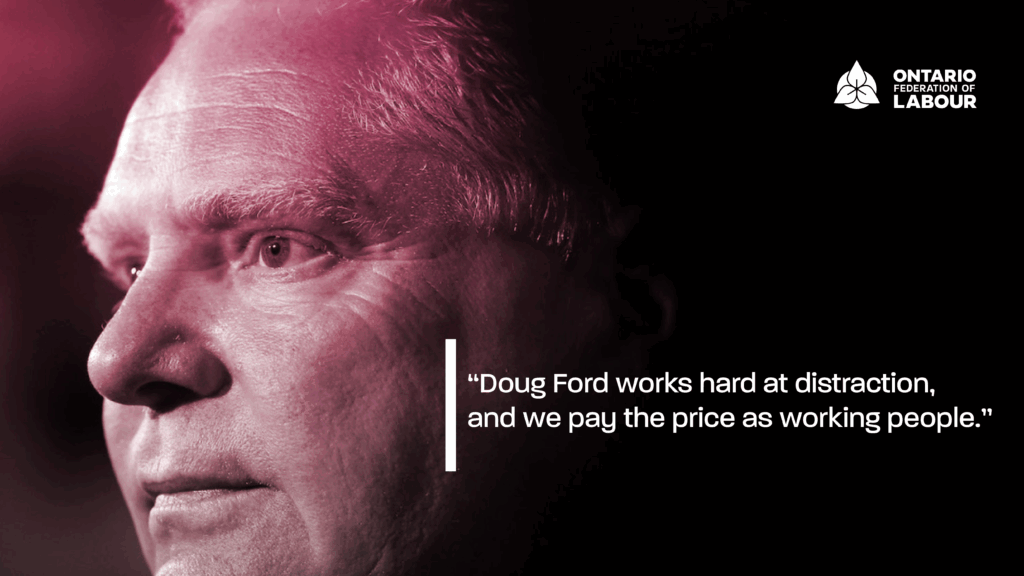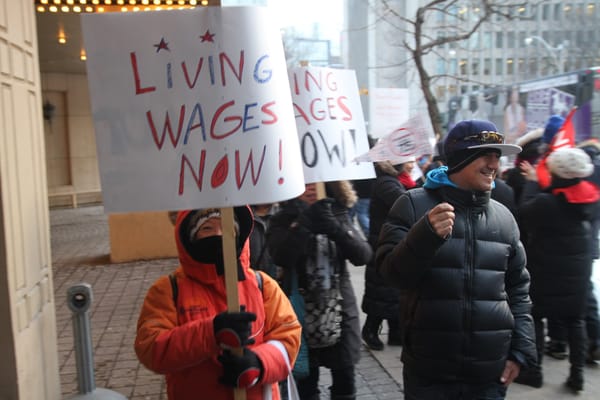
As the job market cools, concerns about a so-called “labour shortage” persist. Getting the story straight about the health of the labour market has real world consequences for workers, and there’s reason to believe the conventional wisdom is off the mark.
It’s become commonplace to describe the post-pandemic labour market as “tight.” By the standard measures, this characterization has been relatively true. From early 2022 until recently, unemployment was historically low (hovering around 5 per cent up to a few months ago), nominal wage growth was healthy and job vacancies were elevated for many months.
This situation led to plenty of discontent among employers displeased with the relatively better structural position of workers in the post-pandemic economy. Employers and their organizations were given ample space in the media to bemoan the troublesome “labour shortage” and call for various political interventions to restore employer class power.
What was for a time described as a momentary consequence of the pandemic is now considered by some to be a long-term crisis. For example, researchers at McKinsey and Company’s Global Institute recently published a report warning of the “persistent challenge” of “labour market tightness.”
The McKinsey authors argue that labour market tightness is a longstanding issue explained in part by the aging workforces of advanced capitalist economies. They warn that the lack of workers means foregone growth, sluggish productivity and falling living standards. According to McKinsey, GDP across the richest countries could have been 0.5 to 1.5 per cent higher in 2023 if job vacancies were fewer.
It all sounds very dire. However, there are reasons to be skeptical about the purported “worker shortage,” in both its short- and long-term variety. The relatively tight labour market only appears as such because our standard measures of unemployment and job vacancies fail to capture workers’ reality.
Let’s start with McKinsey’s claims about the long-term labour shortage. Helpfully, Thomas Ferguson and Servaas Storm were quick to publish a trenchant critique in the Institute for New Economic Thinking of the report they described as capturing “the Zeitgeist of world business elites.”
Ferguson and Storm take particular issue with the McKinsey authors’ use of job vacancy data. By comparing hiring, quit rates and job opening rates over time, they demonstrate that job vacancy data are highly unstable and likely unreliable.
As they show, in contrast to longer-term trends, the “job openings rate” began to surge between 2010 and 2019. During and after the pandemic, recorded job openings spiked even more markedly. According to Ferguson and Servaas’ calculations, there is no basis for these exceptionally higher job vacancies. Rather, it’s the case that posted job openings don’t truly reflect jobs that employers intended to fill.
As the authors explain: “One plausible factor in skewing the job openings rate (and the vacancy ratio) is that digital technologies have dramatically lowered the cost to employers of job posting, recruiting, and evaluating candidates. As firms have become familiar with using the internet, they have begun experimenting with strategic uses of their newfound powers. Over time, the result has been an increase in dubious postings.”
While it’s unclear if Canada’s elevated job vacancy data suffers from the same reliability issues — driven as it has been by real shortages in the health-care sector — this does raise serious questions about the use of job vacancy figures as measures of labour market health.
As Ferguson and Storm also point out, less than two weeks after McKinsey’s report was released, U.S. unemployment rose to its highest level since November 2021 and long-term unemployment “spiked” to 22.2 per cent.
The U.S. Bureau of Labor Statistics reports two measures of unemployment, the “U3” and the “U6.” The former is a conventional measure of unemployment (with some minor differences from the Canadian statistic), while the latter includes discouraged and under-employed workers. The U6 unemployment rate never dropped below 6.7 per cent during the pandemic, and is now 7.8 per cent, representing more than 13.1 million American workers who are without adequate work.
Similarly, the National Jobs for All Network (NJFAN) also produces a measure of true unemployment that it calls the “full count.” According to the NJFAN, in June true U.S. unemployment — including discouraged workers and those working part-time involuntarily — stood at 9.4 per cent of the labour force, or 16.2 million American workers.
By these measures, even if the job vacancy data relied on by the McKinsey researchers reflected true job openings, the U.S. would still have a significant surplus of unemployed workers.
Moreover, by some estimates, half of new hires in the U.S. were previously classified as “out of the labour force” and therefore not counted as “unemployed,” pointing to how abysmally bad the standard measure of unemployment is at capturing labour market slack.
Here in Canada, our standard unemployment data also fails to adequately report the extent of labour under-utilization. But even the conventional account has not been promising as of late. Officially, the unemployment rate was 6.4 per cent in June, having risen 1.3 percentage points since April 2023. In addition, of these unemployed, 17.6 per cent had been without work continuously for 27 weeks or longer, up four percentage points from the previous year. Among those unemployed in May, just 21.4 per cent found work in June, a lower average for the same months in 2017, 2018 and 2019.
Unifor produces a useful companion to Statistics Canada’s Labour Force Survey data, providing a closer look at the full extent of labour market slack in Canada. In June, labour under-utilization stood at 8.3 per cent. This measure includes workers who are waiting for recall or replies, “long-term future starts,” discouraged workers and a portion of involuntary part-time workers. Meanwhile, overall under-employment, which includes people who want work but can’t find it or who don’t have adequate support systems in place to allow for job-seeking, was 15.2 per cent.
Un- and under-employment also remains a persistent issue across many other OECD countries, and has risen after central banks ratcheted up interest rates and economies slowed.
Of course, fear of inflation motivated a large part of the short-term concern over labour market tightness. As the McKinsey report itself puts it, “Tight job markets present both challenges and opportunities. Job seekers find work more easily and may garner higher wages. Yet upward wage pressure can spur inflation and stress businesses, particularly smaller ones.”
The political and financial elite recognize this well.
On July 24, the Bank of Canada lowered its policy rate by 25 basis points, bringing the interest rate down to 4.5 per cent, with additional cuts expected this year. Yet, from the perspective of the central bank, wrestling inflation down and imposing price stability always involved knocking workers down a peg. Throughout the post-pandemic inflation, governor Tiff Macklem frequently warned against inflationary wage expectations and even cautioned employers not to match wage increases to inflation. Now even with prices moving closer to the Bank’s 2 per cent inflation target, the governor still wants to see wage growth slow further, which will likely involve producing more unemployment to dampen demands for pay increases.
To characterize labour markets as suffering from persistent worker shortages under these circumstances is to stretch reality beyond recognition. There are literally millions of people without adequate work across the rich capitalist countries, to say nothing of the millions more in under-developed and exploited nations.
There’s been enough fussing over a largely fictitious labour shortage. Instead, workers need jobs with dignity, good wages and union protection. Getting there requires a willingness to invest public money to produce the things we need, such as robust healthcare and social services, and green energy. Left to its own devices, the private sector leaves millions jobless while a privileged few fret about the scarcity of labour.
Recent Class Struggle Issues
- August 5 | How To Fix The Staffing Crisis In Manitoba’s Health-Care System
- July 29 | ‘Sandwiched’ Caregivers Show Need For Improved Welfare State
- July 22 | Doug Ford Is Letting Migrant Workers Die From Extreme Heat
- July 15 | LCBO Workers Strike To Combat Doug Ford’s Privatization Plans







